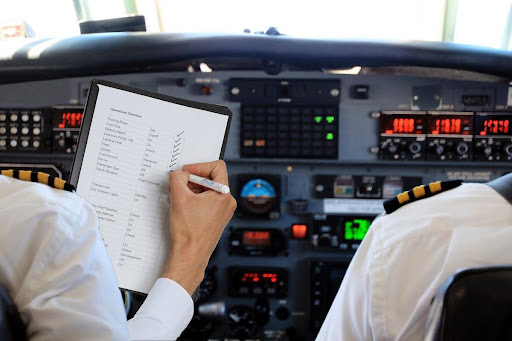The qualifications needed for becoming a pilot go far beyond simple aircraft operation skills. Before they can operationalize an aircraft or helicopter aspiring pilots must accomplish comprehensive pilot-ground training. The essential aviation knowledge foundation gets built up during this vital phase to guarantee proper duties execution by pilots. All aspiring commercial helicopter pilots and private pilots under DGCA PPL (Directorate General of Civil Aviation Private Pilot License) must start their aviation education with ground training.
The acquisition of full flight law comprehension becomes mandatory for pilots upon finishing all required training. Flight regulations command becomes achievable for pilots through training which occurs before their practical trial flights. Let’s examine what ground training comprises and why it is so important to prospective pilots worldwide.
Navigational Aids and Charts
Pilots who want to succeed must become proficient navigators. Students learn how to operate navigation instruments, interpret aeronautical charts, and comprehend map projections during ground training for pilots. They learn how to navigate both visually and with instruments.
Aeronautical publications and charts
Global Positioning Systems (GPS); electronic navigation systems; flight computers and manual computations; and conventional navigational aids
Pilots can create effective itineraries and securely travel between destinations while keeping situational awareness thanks to this knowledge.
Procedures for Flight Planning
Another crucial ability that is taught during ground training is proper flight planning. Students gain the ability to draft thorough flight plans that take into consideration:
Airspace issues are taken into account when choosing a route, Calculations of fuel with suitable reserves, balance and weight calculations,Performance evaluations that take environmental factors into account, alternative airport layouts and emergency plans.
Gaining proficiency in flight planning entails learning to make wise decisions before ever taking off, which is important for DGCA PPL students and those pursuing additional licenses. This planning improves flying safety and reduces risk.
Fundamentals of Aviation Medicine
All license categories include basic aviation medicine in their ground training for pilots. Hypoxia (oxygen shortage), hyperventilation, and decompression sickness are among the situations that students study. To determine whether a person is and is not suitable to fly, they research how drugs, alcohol, and other ailments affect flight safety.
Vision, hearing, and balance in relation to flight operations are also included in this training. Pilots get knowledge of the medical certification standards for their particular license as well as how to maintain their medical fitness.
Radio Protocols and Communications
A key competency for all pilots is effective communication. Standard radio phraseology, appropriate communication methods, and radio navigation are all taught during ground training. Students get knowledge on how to:
Speak with air traffic control; utilize appropriate aviation language;
Comply with established radio protocols; decipher radio navigation messages; and respond to communication breakdowns.
These abilities guarantee accurate and transparent communication between pilots and air traffic controllers, lowering the possibility of miscommunications that can result in safety issues.
Management of Emergency Situations
Pilots who receive extensive ground training are prepared for a variety of emergencies. Students are taught standard operating procedures for scenarios like:
Engine breakdowns, system issues, fires, weather-related crises, medical crises, and forced landings
While fixed-wing students concentrate on airplane crises, those earning a commercial helicopter pilot license study emergency protocols unique to helicopters. Pilots benefit from this training by being able to react composedly and skillfully in emergencies.
Systems for Safety Management
Modern pilots receive ground training that emphasizes safety culture and systematic approaches to risk management. Students gain knowledge of safety reporting protocols, threat and error management, and safety management systems. Pilots who receive this training are better able to adopt a safety-focused mindset that places an emphasis on proactive risk management rather than reactive incident response.
Exams of Theoretical Knowledge
Students must complete thorough written exams covering the ground training curriculum to be eligible for any pilot licensing program. These tests confirm that students have mastered the required theoretical information before moving on to intensive practical training for credentials like the DGCA PPL.
Multiple-choice questions from a variety of areas are usually included in the exam procedure, and passing grades are needed in each subject. Before being allowed to fly alone or move on to more advanced training stages, students must prove they are proficient in every facet of ground training.
Methods of Ground Training
To suit diverse learning types, modern ground training uses a variety of instructional approaches. These could consist of:
Computer-based training programs; self-study using approved materials; and lectures given by certified teachers in a classroom.Group discussions and scenario-based learning ,Flight simulator sessions , Simulation exercises. This multifaceted approach guarantees that students fully comprehend difficult subjects and gets them ready for real-world application throughout flying training.
Outside the Classroom: Utilizing Firsthand Experience
For student pilots, the shift from theoretical ground training to real-world application marks an important turning point. Instructors frequently stress the value of lifelong learning in addition to official ground training for pilots. Proficient pilots keep studying new laws and technological developments because it allows them to stay updated throughout their career. How outstanding pilots differentiate themselves in the industry through their commitment to continuous learning throughout their career. Additionally, throughout advanced training phases, ground knowledge becomes more and more valuable, especially while preparing for DGCA PPL check rides or working toward a commercial helicopter pilot license. In the end, the assurance that comes from careful ground preparation produces safer, more capable aviation workers who can easily handle a variety of flight conditions.
Conclusion:
Pilots’ ground training is much more than just a precondition for flight training; it creates the knowledge base that all aviation professions are founded on. This crucial educational stage builds the cognitive skills required for safe and effective flight operations, from the prospective captain aiming for a commercial helicopter pilot license to the aspirant private pilot pursuing a DGCA PPL.
The breadth and complexity of ground training demonstrate aviation’s unwavering dedication to quality and safety. Pilots build extensive mental models that inform their decision-making throughout their careers by fully comprehending aviation theory before honing their practical skills. Although the thrill of flight training frequently garners more attention, pilots are genuinely empowered to traverse the skies with proficiency and confidence because of the knowledge they acquire during ground training.
Flight instruction delivery needs to match present-day flying operations by addressing the advancements in aviation technology and processes. Aviation safety progresses through continually updated training requirements which concurrently prepares future pilots for the promising challenges of their aviation career.



